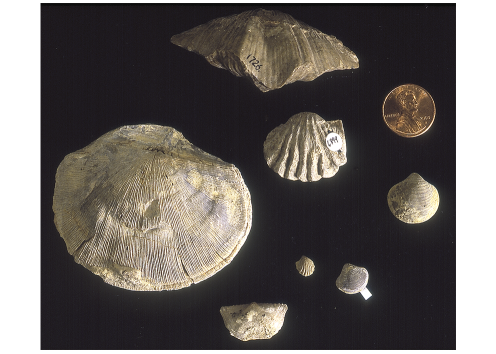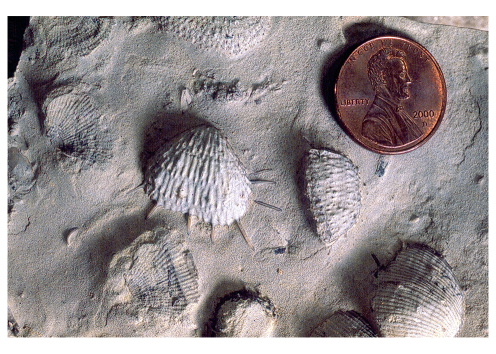Brachiopods

Brachiopods are marine animals that secrete a shell consisting of two parts called valves. Their fossils are common in the Pennsylvanian and Permian limestones of eastern Kansas.
Brachiopods have an extensive fossil record, first appearing in rocks dating back to the early part of the Cambrian Period, about 541 million years ago. They were extremely abundant during the Paleozoic Era, reaching their highest diversity roughly 400 million years ago, during the Devonian Period. At the end of the Paleozoic, however, they were decimated in the mass extinction that marks the end of the Permian Period, about 252 million years ago. Although some brachiopods survived and their descendants live in today's oceans, they never achieved their former abundance and diversity. Only about 300 to 500 species of brachiopods exist today, a small fraction of the perhaps 15,000 species (living and extinct) that make up the phylum Brachiopoda.
Brachiopod shells come in a variety of shapes and sizes. Sometimes the bottom valve is convex like the top valve, but in many species the bottom valve is concave or occasionally conical. In some brachiopods, the top valve is concave and the bottom is convex. The outer surface of the valves may be marked by concentric wrinkles or radial ribs. Some brachiopods have prominent spines, but usually these are broken off and are found as separate fossils.
The shells of living brachiopods typically range in size from less than 0.25 inches to just over 3 inches in length or width. Fossil brachiopods generally fall within this same range, though some adults have shells that are less than 0.04 inches in diameter, and an exceptional few have shells that are 15 inches across.
Most brachiopods live in relatively shallow marine water, up to about 650 feet (200 m), but some species have been found at depths of more than a mile. Because many fossils species are found in shales, which form from deposits of mud and silt, we know that some brachiopod species thrived in muddy environments.
Brachiopods are one of most common fossils found in the Pennsylvanian rocks in eastern Kansas. They are also common in the younger Permian rocks. However, in spite of their abundance in many Cretaceous rocks worldwide, brachiopods are almost never found in the Cretaceous rocks of Kansas.
Because of their worldwide abundance, diversity, and rapid evolution in the Paleozoic, brachiopod fossils are useful indicators of the ages of different rock layers. By matching the brachiopod species contained within rocks deposited in different locations, paleontologists can determine that the rock units were deposited at the same time.
Stratigraphic Range: Lower Cambrian to Holocene.
Taxonomic Classification: Brachiopods belong to Kingdom Animalia, Phylum Brachiopoda. The phylum is divided into three subphyla, the Linguliformea, Craniiformea, and Rhynchonelliformea.
Text and photos from Windows to the Past: A Guidebook to Common Invertebrate Fossils of Kansas, Kansas Geological Survey Educational Series 16.
Sources
Boardman, R. S., Cheetham, A. H., and Rowell, A. J., 1987, Fossil Invertebrates: Boston, Blackwell Scientific Publications, 713 p.
Clarkson, E. N. K., 1979, Invertebrate Palaeontology and Evolution, 3rd Edition: London, Chapman and Hall, 434 p.
Kaesler, R. L., ed., 1997, Brachiopoda, Revised, Vol. 1 (Introduction), Part H; in, Treatise on Invertebrate Paleontology: Boulder, Colorado, and Lawrence, Kansas, Geological Society of America and The University of Kansas, 539 p.
Kaesler, R. L., ed., 2000, Brachiopoda, Revised, Vols. 2 and 3 (Linguliformea, Craniiformea, and Rhynchonelliformea, part), Part H; in, Treatise on Invertebrate Paleontology: Boulder, Colorado, and Lawrence, Kansas, Geological Society of America and The University of Kansas, 919 p.
Moore, R. C., Lalicker, C. G., and Fischer, A. G., 1952, Invertebrate Fossils: New York, McGraw-Hill Book Co., 766 p.
University of California Museum of Paleontology, 1995, Brachiopoda—Fossil Record (Dec. 24, 2003).
University of California Museum of Paleontology, 1995, Introduction to the Brachiopoda—Of lamp shells and lophophores (June 29, 2000).
Voorhies, M. R., 1994, Shark-infested coral seas; in, The Cellars of Time—Paleontology and Archaeology in Nebraska: Nebraska Game and Parks Commission, NEBRASKAland Magazine, Vol. 72, no. 1, p. 11-19.

